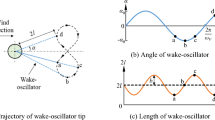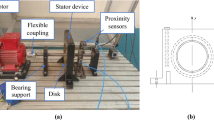Abstract
This paper presents real-time monitoring data and analysis results of the non-stationary vibrations of an operational wind turbine. The advanced time-frequency spectrum analysis reveals varied non-stationary vibrations with timevarying frequencies, which are correlated with certain system natural modes characterized by finite element analysis. Under the effects of strong wind load, the wind turbine system exhibits certain resonances due to blade passing excitations. The system also exhibits certain instabilities due to the coupling of the tower bending modes and blade flapwise mode with blade passing excitations under the variation of wind speed. An analytical model is used to elaborate the non-stationary and instability phenomena observed in experimental results. The properties of the nonlinear instabilities are evaluated by using Lyapunov exponent estimation.
Similar content being viewed by others
References
Abichou B, Flórez D, Sayed–Mouchaweh M, Toubakh H, Bruno F and Girard N (2014), “Fault Diagnosis Methods for Wind Turbines Health Monitoring: a Review,” Proceedings of European Conf. of the Prognosis and Health Management Society.
Anegawa1 N, Fujiwara1 H, Okabe A and Matsushita1 O (2008), “Resonance and Instability of Blade-Shaft Coupled Bending Vibrations with In-plane Blade Vibration,” International Journal of Fluid Machinery and Systems, 1: 1–12.
Antoniadou N, Dervilis E, Papatheou A, Maguire E and Worden K (2014), “Aspects of Structural Health and Condition Monitoring of Offshore Wind Yurbines,” Phil. Trans. R. Soc. A, 373: 20140075.
Avendaño-Valencia LD and Fassois SD (2014), “Stationary and Non-stationary Random Vibration Modelling and Analysis for an Operating Wind Turbine,” Mechanical Systems and Signal Processing, 47: 263–285.
Azevedo HDM, Araújo A M and Bouchonneau A (2016), “A Review of Wind Turbine Bearing Condition Monitoring: State of the Art and Challenges,” Renewable and Sustainable Energy Reviews, 56: 368–379.
Bajri A, Høgsberg J and Rüdinger F (2018), “Evaluation of Damping Estimates by Automated Operational Modal Analysis for Offshore Wind Turbine Tower Vibrations,” Renewable Energy, 116: 153–163.
Baraniuk RG and Jones DL (1993), “Signal-Dependent Time Frequency Representation: Optimal Kernel Design,” IEEE Trans Signal Process, 41: 1589–1602.
Bechly ME and Clausen PD (1997), “Structural Design of a Composite Wind Turbine Blade Using Finite Element Analysis,” Comput Struct, 63(3): 639–646.
Boashash B (2003), Time Frequency Signal Analysis and Processing: A Comprehensive Reference, Elsevier, Oxford, UK.
Bottasso CL, Croce A, Savini B, Sirchi W and Trainelli L (2006), “Aero-servo-elastic Modeling and Control of Wind Turbines Using Finite-Element Multibody Procedures,” Multibody System Dynamics, 16(3):291–308.
Brasil RMLR, Feitosa LCS, Manoel BJ (2006), “A Nonlinear and Non-ideal Wind Generator Supporting Structure,” Appl Mech Mater, 5–6: 433–442.
Brown R, Bryant P and Abarbanel HDI (1991), “Computing the Lyapunov Exponents of a Dynamical System from Observed Time Series,” Phys. Rev. A, 34:2787–2806.
Chen G and Liu XD (2016), Friction Dynamics, Elsevier-Woodhead Publishing, 2016, Duxford, UK.
Castellani F, Buzzoni M, Astolfi D, D’Elia G, Dalpiaz G and Terzi L (2017), “Wind Turbine Loads Induced by Terrain and Wakes: An Experimental Study through Vibration Analysis and Computational Fluid Dynamics,” Energies, 10: 1839; doi:10.3390/en10111839.
Chiang CH, Huang CL, Hsu KT, Cheng CC, Yu CP and Lai J (2015), “Time Frequency Analyses of Vibrations of Wind Turbine Towers,” Proc. SPIE 9437, Structural Health Monitoring and Inspection of Advanced Materials, Aerospace, and Civil Infrastructure, 94371C.
Cross P and Ma X (2014), “Nonlinear System Identification for Model-Based Condition Monitoring of Wind Turbines,” Renew Energy, 71: 166–175, https://doi.org/10.1016/j.renene.2014.05.035.
Dao PB, Staszewski WJ, Barszcz T and Uhl T (2018), “Condition Monitoring and Fault Detection in Wind Turbines Based on Cointegration Analysis of SCADA Data,” Renewable Energy, 116: 107–122.
Dempsey PJ and Sheng S (2013), “Investigation of Data Fusion Applied to Health Monitoring of Wind Turbine Drivetrain omponents,” Wind Power, 16(4): 479–489.
Feng ZP and Liang M (2014), “Fault Diagnosis of Wind Turbine Planetary Gearbox Under Nonstationary Conditions via Adaptive Optimal Kernel Time-Frequency Analysis,” Renewable Energy, 66: 468–477.
Gao Z and Dai X (2014), “From Model, Signal to Knowledge: A Data-Driven Perspective of Fault Detection and Diagnosis,” IEEE Transactions on Industrial Informatics, 9(4): 2226–2238.
Gao Z, Cecati C and Ding SX (2015), “A Survey of Fault Diagnosis and Fault-Tolerant Techniques–PartI: Fault Diagnosis with Model-Based and Signal-Based Approaches,” IEEE Trans. Ind. Electron, 62: 3757–3767, https://doi.org/10.1109/TIE.2015.2417501.
Gao Z, Cecati C and Ding SX (2015), “A Survey of Fault Diagnosis and Fault-Tolerant Techniques–PartI: Fault Diagnosis with Knowledge-based and Hybrid/Active Approaches,” IEEE Trans. Ind. Electron, 62: 3768–3774, https://doi.org/10.1109/TIE.2015.2419013.
Goeij WC, van Tooren MJL and Beukers A (1999), “Implementation of Bending-Torsion Coupling in the Design of a Wind-Turbine Rotor-Blade,” Appl Energy, 63(3): 191–207.
Gonzalez-Carrato RRDLH (2017), “Sound and Vibration-Based Pattern Recognition for Wind Turbines Driving Mechanisms,” Renewable Energy, 109: 262–274.
Hameed Z, Hong YS, Cho YM, Ahn SH, Song CK (2009), “Condition Monitoring and Fault Detection of Wind Turbines and Related Algorithms: A Review,” Renewable and Sustainable Energy Reviews, 13(1): 1–39.
Hansen MH, Thomsen K and Fuglsang P (2006), “Two Methods for Estimating Aeroelastic Damping of Operational Wind Turbine Modes from Experiments,” Wind Energy, 9: 179–191.
Hansen MH (2007), “Aeroelastic Instability Problems for Wind Turbines,” Wind Energy, 10(6): 551–577.
Hansen MH (2011), “Turbine Aero-Servo-Elasticity,” 2011 Wind Turbine Control Symposium, Risø DTU, Technical University of Denmark
Harte M, Basu B and Nielsen SRK (2012), “Dynamic Analysis of Wind Turbines Including Soil-Structure Interaction,” Engineering Structures, 45: 509–518.
Henriquez P, Alonso JB, Ferrer MA, Travieso CM (2014), “Review of Automatic Fault Diagnosis Systems Using Audio and Vibration Signals,” IEEE Trans. Syst. Man Cybern. Syst., 44: 642–652, https://doi.org/10.1109/TSMCC.2013.2257752.
Hutchins S and Campbell D (2009), “Estimating the Time to Reach a Target Frequency in Singing, The Neurosciences and Music III: Disorders and Plasticity,” Ann. N.Y. Acad. Sci., 1169: 116–120.
Ishida Y and Yamamoto T (2012), Linear and Nonlinear Rotor Dynamics: A Modern Treatment with Applications, Wiley.
Jones DL and Baraniuk RG (1995), “An Adaptive Optimal Kernel Time-Frequency Representation,” IEEE Trans Signal Process, 43: 2361–2371.
Joshuva A and Sugumaran V (2017), “A Data Driven Approach for Condition Monitoring of Wind Turbine Blade Using Vibration Signals Through Best-First Tree Algorithm and Functional Trees Algorithm: A Comparative Study,” ISA Transactions, 67: 160–172.
Juan C and Jimenez JD (2011), “Nonlinear Vibration Analysis of Wind Turbine Blades,” 13th World Congress in Mechanism and Machine Science, 19–25 June, 2011.
Kang N, Park SC, Park J and Atluri SN (2016), “Dynamics of Flexible Tower-Blade and Rigid Nacelle System: Dynamic Instability due to their Interactions in Wind Turbine,” Journal of Vibration and Control, 22(3): 826–836.
Kantz H and Schreiber T (1997), Nonlinear Time Series Analysis, Cambridge: Cambridge University Press.
Kellie B, O’Callaghan P, Pasker J and Kitchin T (2010), “Design, Prototype and Test of a Small Wind Turbine for Rural Alaska,” Senior Design Final Report, UAF, Alaska, April 28, 2010.
Kong C, Bang J and Sugiyama Y (2005), “Structural Investigation of Composite Wind Turbine Blade Considering Various Load Cases and Fatigue Life,” Energy, 30(11–12): 2101–2114.
Kuo YC, Hsieh CT, Yau HT and Li YC (2015), “Study on Unified Chaotic System-based Wind Turbine Blade Fault Diagnostic System,” Int. J. Bifurc. Chaos, 25: 1550042, https://doi.org/10.1142/S021812741550042X.
Kusiak A and Li W (2011), “The Prediction and Diagnosis of Wind Turbine Faults,” Renewable Energy, 36(1): 16–23.
Langre E (2006), “Frequency Lock-in is Caused by Coupled-Mode Flutter,” Journal of Fluids and Structures, 22: 783–791.
Larsen JW and Nielsen SRK (2007), “Nonlinear Parametric Instability of Wind Turbine Wings,” Journal of Sound and Vibration, 299: 64–82.
Li DS, Ho SCM, Song GB, Ren L and Li HN (2015), “A Review of Damage Detection Methods for Wind Turbine Blades,” Smart Materials and Structures, 24: 3–11.
Leitea GDNP, Araújoa AM and Rosasb PAC (2018), “Prognostic Techniques Applied to Maintenance of Wind Turbines: A Concise and Specific Review,” Renewable and Sustainable Energy Reviews, 81: 1917–1925.
Lu B, Li Y, Wu X, Yang ZZ (2009), “A Review of Recent Advances in Wind Turbine Condition Monitoring and Fault Diagnosis,” Power Electronics and Machines in Wind Applications, PEMWA 2009, IEEE, DOI: 10.1109/PEMWA.2009.5208325.
Lu B and Sharma SK (2009), “A Literature Review of IGBT Fault Diagnostic and Protection Methods for Power Inverters,” IEEE Transactions on Industry Applications, 45(5): 1770–1777.
Mabrouk IB, Hami AEi, Walha L, Zghal B and Haddar M (2017), “Dynamic Vibrations in Wind Energy Systems: Application to Vertical Axis Wind Turbine,” Mechanical Systems and Signal Processing, 85: 396–414.
Maheswari RU and Umamaheswari R (2017), “Trends in Non-Stationary Signal Processing Techniques Applied to Vibration Analysis of Wind Turbine Drivetrain–A contemporary Durvey,” Mechanical Systems and Signal Processing, 85: 296–311.
Márquez G, Tobias, FP, Pérez AMP, Papaelias JMM (2012), “Condition Monitoring of Wind Turbines: Techniques and methods,” Renewable Energy, 46: 169–178.
Martinez-Luengo M, Kolio A and Wang L (2016), “Structural Health Monitoring of Offshore Wind Turbines: A Review Through the Statistical Pattern Recognition Paradigm,” Renewable and Sustainable Energy Reviews, 64: 91–105.
Mollasalehi E, Wood D and Sun Q (2017), “Indicative Fault Diagnosis of Wind Turbine Generator Bearings Using Tower Sound and Vibration,” Energies, 10: 1853, doi:10.3390/en10111853.
Murtagh PJ, Basu B and Broderick BM (2005), “Along-Wind Response of a Wind Turbine Tower with Blade Coupling Subjected to Rotationally Sampled Wind Loading,” Eng Struct, 27(8): 1209–1219.
Nie M and Wang L (2013), “Review of Condition Monitoring and Fault Diagnosis Technologies for Wind Turbine Gearbox,” Procedia CIRP, 11: 287–290.
Pashazadeh V, Salmasi FR, Araabi BN (2018), “Data Driven Sensor and Actuator Fault Detection and Isolation in Wind Turbine Using Classifier Fusion,” Renewable Energy, 116: 99–106.
Riziotis VA, Voutsinas SG, Politis ES and Chaviaropoulos PK (2004), “Aeroelastic Stability of Wind Turbines,” Wind Energy, 7: 373–392.
Rossenstein MT, Collins JJ and Deluca CJA (1993), “Practical Method for Calculating Largest Lyapunov Exponents from Small Data Sets,” Physica D, 65(1): 117–134.
Saidi L, Ali JB, Bechhoefer E and Benbouzid M (2017), “Wind Turbine High-speed Shaft Bearings Health Prognosis Through a Spectral Kurtosis-Derived Indices and SVR,” Applied Acoustics, 120: 1–8.
Sheng S and Veers P (2011), “Wind Turbine Drivetrain Condition Monitoring–An Overview, Presented at the Mechanical Failures Prevention Group,” Applied Systems Health Management Conference 2011, Virginia Beach, Virginia, May 10–12.
Sheng S (2015), “Prognostics and Health Management of Wind Turbines: Current Status and Future Opportunities National Renewable Energy Laboratory (NREL), U.S.A.,” Probabilistic Prognostics and Health Management of Energy Systems Workshop, December 14–15, 2015, IIha Solteira, SP, Brazil.
Skjoldan PF and Hansen MH (2013), “Effects of Extreme Wind Shear on Aeroelastic Modal Damping of Wind Turbines,” Wind Energ., 16: 401–415.
Sparr T and Krane B (2003), “Time–Frequency Analysis of Vibrating Targets in Airborne SAR Systems,” IEE Proceedings - Radar, Sonar and Navigation, 150(3): 173–176.
Takoutsing PT, Wamkeue R, Ouhrouche M, Slaoui-Hasnaoui F, Tameghe TA and Ekemb G (2014), “Wind Turbine Condition Monitoring: State-of-the-Art Review, New Trends, and Future Challenges,” Energies, 7: 2595–2630, doi:10.3390/en7042595.
Upegui-Botero FM, Huerta-López CI, Caro-Cortes JA, Martínez-Cruzado JA and Suarez-Colche LE (2012), “Joint Time–Frequency Analysis of Seismic Records,” 15 WCEE, Lisboa, 2012.
Yau HT and Wang MH (2015), “Chaotic Eye-Based Fault Forecasting Method for Wind Power Systems,” IET Renew. Power Gener, 9: 593–599.
Zhang DM, Li ZL and Zhang RH (2005), “Sea Sediment Parameters Inversion Based on Adaptive Time Frequency Analysis,” Chinese Journal of Acoustics, 30(5): 415–419.
Zheng M, Yang Z, Yang S and Still B (2017), “Modeling and Mitigation of Excessive Dynamic Responses of Wind Turbines Founded in Warm Permafrost,” Engineering Structures, 148: 36–46.
Author information
Authors and Affiliations
Corresponding author
Rights and permissions
About this article
Cite this article
Wait, I., Yang, Z.J., Chen, G. et al. Wind-induced instabilities and monitoring of wind turbine. Earthq. Eng. Eng. Vib. 18, 475–485 (2019). https://doi.org/10.1007/s11803-019-0515-8
Received:
Accepted:
Published:
Issue Date:
DOI: https://doi.org/10.1007/s11803-019-0515-8




